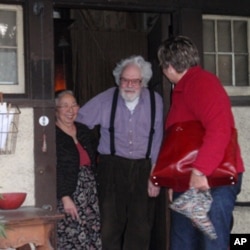At 91, Philip Theil lives in a century-old house in Seattle's University District and that's the way he wants to keep it.
"As far as I'm concerned, I would not like to leave this place," says the naval architect. "Living in a group situation is something I couldn't tolerate. I'd kill myself before I had to do that."
Many elderly Americans, who can no longer manage on their own, spend their final years in a nursing home or assisted living facility. However, the vast majority of seniors would prefer to live in their own homes as long as possible.
Theil says he and his wife manage pretty well right now. Their two-story house is stuffed to the rafters with the books, artwork and projects of a life well lived. But the couple can feel their advancing age and realize they'll soon need more help with basic household chores, like changing that light bulb at the top of the stairs.
"To change that tube, I have to bring in a stepladder and put it partly on the landing and partly on the stairs and climb up," Theil says. "It's kind of trepiditious."
In the old days, the Theils could ask their children to climb up there or maybe the teenager from down the street when he came over to mow the lawn. But those young helpers have grown up and gone.
"We have kids and we call them occasionally, but one lives in Munich, Germany, another lives in London and a third lives in Los Angeles," Theil says. "They're not going to drop around for a weekend call type of thing."
Aging in place
So the Theils are looking into joining a "virtual village," a new breed of nonprofit which provides a local network of volunteers and service providers dedicated to helping the elderly age in place.
They assist seniors with anything from transportation and grocery delivery to home repairs and dog walking. The concept originated in Boston a decade ago and has since grown into what you might call a national movement. An informal network of villages includes more than 150 others in development or already serving clients.
"The 'silver tsunami' is the term that's tossed about," says Tom La Pointe, who was recently hired to start a village organization in the small town of Moscow, Idaho. "We are trying to get ready for what is anticipated to be a glut of baby boomers retiring within the next 20 or so years."
La Pointe's nonprofit, My Own Home, aims to serve a vast middle ground of seniors; those who are too well off to qualify for public services, but not rich enough to afford their own staff to do things like change light bulbs.
Helping hand for a fee
In most cases, the villages charge a membership fee, which can range from about $100 to more than $1000 per year. Once you're a member, some of the services are free, while others are provided by a vetted third party vendor that might offer a discounted rate.
Judy Kinney directs an aging in place startup called North East Seattle Together (NEST).
"When someone calls us, they may say, 'I need help with transportation.' We're going to work with them to see if it is a volunteer that helps, if it's a vetted vendor that helps or there is a community service in place," Kinney says. "That's the process we're going to do when someone picks up the phone. People have called it a concierge. People call and say I need this help. We help you figure out the best choice."
Kinney's group is one of about half a dozen in the Pacific Northwest expected to launch in the next several months. At a village already in operation in central Oregon, the most-requested services are rides to the doctor, simple home repairs, help with grocery shopping and picking up prescriptions or big items.
In Moscow, Idaho, Tom La Pointe imagines snow shoveling, yard work or computer-tech support will also rank high.
"On the other hand, if you need daily care, 24/7 care, that is not what we do," La Pointe says. "We don't do bathing services for example. We are here and we exist for the folks who might need a little extra assistance."
La Pointe says his nonprofit is not a charity. It, like the others, will charge elderly clients a membership fee. He hopes 40 seniors will sign up by the end of this year.
Those who do might find out if it's possible to recreate old-fashioned social connections to suit a modern world.








